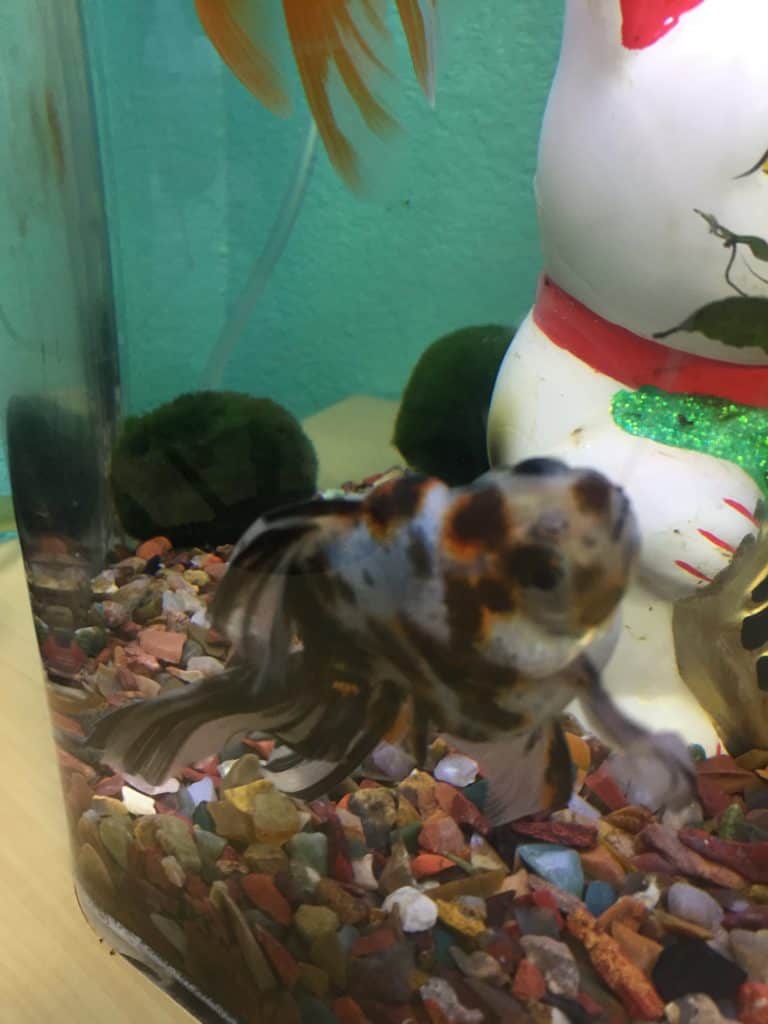Behavioral signs of disease in fish are harder to spot for most owners than physical signs of disease. By watching your fishes’ behavior consistently, for at least 5-10 minutes per day, you will be able to determine what is normal or abnormal for your fish. Some “fun fish quirks” may actually be a sign of a serious disease.
Swimming Behavior
All fish should swim level nose to tail and left to right. Fish that swim with a list or tilt are not normal. Some fish may have developmental abnormalities or healed trauma, such as a missing fin, which causing them to swim abnormally. Usually, fish swimming with a list or tilt will need to be evaluated by an aquatic veterinarian to assess the cause.
You may notice your fish avoiding certain areas of your pond or tank. Depending on your system setup, flow and any decor, you may have dead spots in your pond that your fish will avoid due to low oxygen load.
Your fish might not swim swim much further than the immediate area around your waterfall. This can be hard to tune into unless you watch your fish for awhile. They may leave the area for food or not. This can be an indication that your water doesn’t have enough oxygen or your pH is starting to crash.
Appetite
Most pet fish love to eat. Some fish may have a bigger appetite than others, especially breeding, pregnant females. If you have a fish that doesn’t want to eat, assess if they are able to get at their food. Is there too much competition? Are you feeding an appropriate diet? Is your food old, stale or moldy?
Some fish may have an off day or two and return to their normal appetite. Usually, this is nothing to be too concerned about unless your fish doesn’t eat for 3 days or more. You don’t want to wait too long to get your fish help or they may not have enough energy to recover. It is also worth an assessment if your fish has repeated sessions of 1 to 2 days of not eating over weeks to months.
Buoyancy
Neutral buoyancy is critical for most fish. If they float too much or sink too much, they can become stressed and have secondary issues. Some fish, like koi and goldfish, are physostomous fish, with a duct between their swim bladder and esophagus. Too much vigorous surface eating can lead to floating post-meal. Other species are physoclistous, and remove air from their blood stream to inflate their swim bladder. These fish are more prone to buoyancy disorders with water chemistry problems, especially those involving the pH of their water.
And, no, your fish is not constipated and peas don’t have any additional fiber than regular fish food. They work because they sink.
Flashing
One of the easiest behavioral clues for fish owners to pick up on is a behavior known as flashing. Since fish do not have fingers, arms or legs to scratch themselves, they will use their environment to itch themselves. They may use the bottom or sides of their system, any protruding filtration/plumbing or decorative items.
Often, owners will only see the after effects of flashing. This may include missing scales, bruising or traumatic wounds. Although often caused by parasites, sometimes, another primary stressor has knocked out the fishes’ immune system, giving the parasites entrance to the fish. Again, like other behavioral signs of disease in fish, you must take some time to watch your fish in order to note some of the more subtle signs of disease.


Good Morning,
We have a fish pond about 12 x 18, with 25 gold fish in the pond. The pond has a waterfall and 2 aerators, plus the pump so that fresh water is coming and going 24/7. We feed Tetra Fin Plus during the spring, summer and fall, and Tetra’s Spring and Fall Diet in the Winter. We are in SC, so the winters are typically mild, and pond temp never goes below 50. The pond is cleaned twice a year, and in the spring, emptied and thoroughly rinsed down.
We have aquatic plants – water lilies and colocasia mostly.
We have one fish that is concerning, but I see not information that relates to her. She is the smallest of all, and swims with a wiggle that is constant. She also only swims for short periods, then goes and rests on a rock ledge (below water of course). Her rests are only a few seconds, then she swims more – about 10 seconds, then rests. She reposts this in the evening when we are feeding and watching them closely – usually we are out there about 20 minutes at night to observe them.
Is there anything wrong with her? She has no outside sores, no fin issue, no mouth sores, and doesn’t seem to be gasping at the surface for air (none of our fish do that).
I would appreciate any guidance you may have – there is no one here who can help me with this one, including our “pond guy”.
Gayle Weibley Wolman
If you are concerned about your fish, please call (831) 278-1081 for veterinary assistance. If you are outside California and Nevada, please visit https://fishvets.org or https://wavma.org